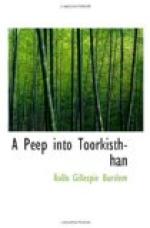The chief, being the lightest, claimed the privilege of being drawn up first, which was readily agreed to; and so in succession each when he had mounted assisted in drawing up his companions, till at last we were all safely landed at the top, out of the reach of any ordinary sized devil. We soon emerged into the open air, covered with dust from head to foot like Indian Faqueers, after having been for nearly four hours wandering in the bowels of the earth. Our followers soon regained their courage now that the danger was past, and each in turn began to boast of his own valour and sneer at the pusillanimity of his comrade; but all agreed that nothing on earth or in heaven should ever tempt them again to visit the ice-caves of Yeermallick.
CHAPTER XII.
On the 13th of July we bade adieu to our friend Shah Pursund Kh[=a]n, who accompanied us a short distance on our way, after in vain endeavouring to induce us to remain with him for some time longer, this we could not accede to, but promised, if our time permitted, to pay him a lengthened visit on our return. We had a long march this day, the distance being nearly eighteen miles; but our beasts of burden were much the better for their day’s halt, and, the greater part of the road being a descent, we reached Rhoeh, where we pitched our tents, in very good time. The first few miles were along the delightful valley of the Doaub, which we reluctantly quitted, and after crossing a low ridge descended through broken country till we reached the foot of the hills, where I observed for the first time a genuine Tartar krail, composed of a number of small black blanket tents fastened to a kind of wattle. In the plain of Rhoeh is a small mud fort in a dilapidated state, and uninhabited; the village itself was not of any importance, the habits of the people being evidently migratory.
The Jerboa is a native of this country as well as the steppes of Tartary, where it is most commonly found in the shrubless plains; in form it is a miniature of the kangaroo, to which in some of its peculiarities it bears a close resemblance, though in size it is very little larger than our common English rat. The name of the “Vaulting Rat,” by which it is known among naturalists, is very applicable. These little animals burrow deeply in the ground, and the method of dislodging them adopted by us was the pouring a quantity of water into their holes, which causes them to rush out at another aperture, when they commence leaping about in a surprising manner until they observe another burrow and instantly disappear. If chased, they spring from the hind quarters, darting about here and there, and affording great amusement to the pursuers. It is difficult to hold them, as they are rarely grasped without losing a portion of their long and beautiful tails. The forelegs are much shorter than the hind ones, the ears are very large and silky, and the eye surpassingly black and brilliant. It is a harmless animal, and no doubt when tamed would be perfectly domesticated.




